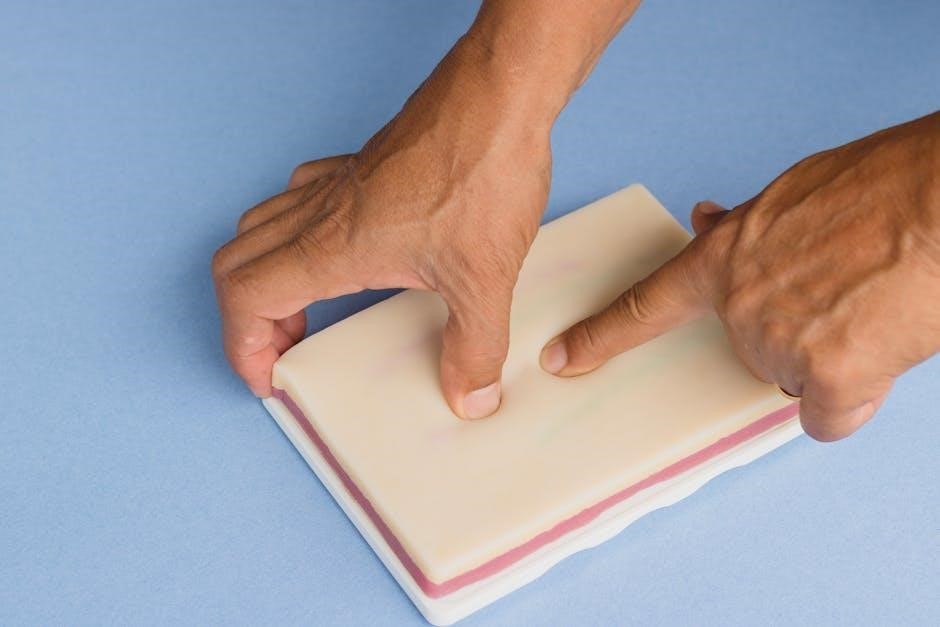house tree person test interpretation pdf
The House-Tree-Person (HTP) test is a projective psychological tool where individuals draw a house‚ tree‚ and person to assess personality‚ emotional state‚ and cognitive functioning. It is widely used in clinical and non-clinical settings to explore self-perception‚ emotional well-being‚ and inner conflicts‚ offering insights into an individual’s psyche through creative expression.
1.1 Origins and Purpose of the Test
The House-Tree-Person (HTP) test was developed by John Buck in 1948 as a projective psychological tool. It is designed to explore an individual’s subconscious thoughts‚ emotions‚ and personality traits. The test requires the subject to draw a house‚ tree‚ and person‚ which are then analyzed for symbolic meaning. The purpose is to gain insight into the person’s emotional state‚ cognitive functioning‚ and interpersonal relationships. This non-verbal assessment is widely used in clinical and non-clinical settings to uncover underlying psychological dynamics and behavioral tendencies.
1.2 Overview of the Test’s Structure

The HTP test involves drawing three elements: a house‚ a tree‚ and a person. The test is typically administered on a blank sheet of paper with minimal instructions‚ allowing the subject to express freely. The drawings are completed in sequence‚ and the process is observed for behavioral cues. No specific artistic skills are required‚ making it accessible to all individuals. The test’s structure is designed to reveal subconscious thoughts and emotions through symbolic representation‚ providing a comprehensive view of the individual’s psychological state and personality traits.
The House in the HTP Test
The house symbolizes family‚ security‚ and emotional well-being. It reflects the individual’s inner world‚ including their sense of safety and relationships within their environment.
2.1 Symbolism of the House
The house in the HTP test represents the individual’s family life‚ emotional security‚ and sense of belonging. It symbolizes the person’s inner world‚ reflecting their feelings about home‚ safety‚ and relationships. The house often signifies the unconscious need for protection and stability‚ serving as a metaphor for the self and its emotional foundation. It also reveals how the individual perceives their family dynamics and personal space. The house’s structure and details can indicate feelings of warmth‚ isolation‚ or conflict‚ providing insight into the person’s emotional well-being and psychological state.
2.2 Key Features to Analyze: Windows‚ Door‚ Roof‚ and Walls
The windows of the house symbolize communication and openness‚ with their presence or absence reflecting the individual’s willingness to engage with others. The door represents accessibility and approachability‚ while the roof signifies protection and intellectual functioning. Walls indicate personal boundaries and defenses. Analyzing these features helps assess emotional security‚ social interactions‚ and the individual’s sense of safety. For example‚ barred windows or a heavily fortified door may suggest feelings of isolation or defensiveness. These elements collectively provide insights into the person’s emotional and psychological state.

2.3 Interpretation of House Drawing Characteristics
The interpretation of house drawings focuses on understanding the individual’s emotional security‚ family dynamics‚ and personal growth. A well-detailed house may signify stability and organization‚ while a simplistic or distorted house could indicate emotional neglect or instability. The presence of a chimney or smoke may reflect warmth and family life‚ whereas a lack of windows might suggest isolation. The size and proportions of the house can also reveal self-perception and aspirations. These elements collectively offer insights into the person’s psychological state and their perception of home and family life.
The Tree in the HTP Test
3.1 Symbolism of the Tree
The tree in the HTP test symbolizes personal growth‚ emotional strength‚ and inner balance. It reflects an individual’s psychological development‚ self-esteem‚ and ability to cope with challenges.

The tree in the House-Tree-Person (HTP) test represents the individual’s emotional and psychological state. It symbolizes personal growth‚ emotional stability‚ and the ability to connect with others. A well-drawn tree may indicate resilience‚ while a sparse or uneven one could suggest emotional struggles. The tree also reflects self-esteem‚ with details like the trunk’s strength and branch distribution offering insights into confidence and interpersonal relationships. It serves as a metaphor for how individuals navigate life’s challenges and maintain balance in their emotional lives.
3.2 Key Features to Analyze: Trunk‚ Branches‚ Leaves‚ and Roots
In the HTP test‚ the tree’s trunk symbolizes emotional stability and resilience‚ with its thickness and straightness indicating inner strength. Branches reflect social connections and interpersonal skills‚ while their direction and distribution reveal outgoing or withdrawn tendencies. Leaves represent emotional expression and creativity‚ with their abundance or scarcity suggesting openness or repression. Roots‚ often overlooked‚ signify grounding and past experiences‚ offering insights into an individual’s sense of security and how they handle life’s challenges. These features collectively provide a deeper understanding of the person’s psychological state.
3.3 Interpretation of Tree Drawing Characteristics

The interpretation of the tree drawing focuses on emotional stability‚ social interactions‚ and personal growth. A sturdy trunk may indicate resilience‚ while a fragile one could suggest vulnerability. Branches pointing upward often symbolize positive relationships‚ whereas downward-pointing branches may reflect emotional struggles. Leaves abundant in number and color can signify creativity and emotional expressiveness‚ while sparse or wilted leaves might indicate repression. Roots that are well-defined often represent a strong sense of grounding and past experiences‚ offering insights into how an individual copes with stress and change. Together‚ these elements reveal underlying psychological dynamics.

The Person in the HTP Test
The person drawing reflects self-perception‚ personality traits‚ and emotional well-being‚ offering insights into an individual’s inner world and social interactions through facial expressions‚ posture‚ and clothing details.
4.1 Symbolism of the Person
The person in the HTP test represents the individual’s self-perception‚ emotional state‚ and social identity. It symbolizes how one views themselves in relation to others and their environment. Facial expressions‚ posture‚ and clothing details reveal emotional stability‚ self-esteem‚ and coping mechanisms. The drawing reflects internal feelings‚ interpersonal skills‚ and adaptability to life circumstances. It also provides insights into the person’s psychological well-being‚ highlighting areas of confidence or vulnerability. The person’s depiction is a direct expression of their inner world and external interactions‚ making it a crucial element in understanding the test-taker’s personality and emotional health.
4.2 Key Features to Analyze: Face‚ Body‚ Clothing‚ and Posture
In the HTP test‚ the person’s drawing is examined for specific features that reveal psychological traits. The face’s expression and symmetry indicate emotional stability and self-perception. The body’s proportion and posture reflect confidence or insecurity. Clothing details‚ such as style and completeness‚ suggest social identity and self-image. Posture may signify openness‚ defensiveness‚ or emotional strain. These elements provide insights into the individual’s mental state‚ interpersonal skills‚ and adaptability‚ offering a comprehensive view of their personality and emotional well-being through artistic expression.
4.3 Interpretation of Person Drawing Characteristics
The interpretation of the person drawing focuses on understanding the individual’s self-perception‚ emotional state‚ and social behaviors. A well-proportioned face may indicate emotional balance‚ while distortions could suggest inner conflicts. The body’s posture and stance reveal confidence or defensiveness. Clothing details‚ such as neatness or extravagance‚ reflect self-image and social identity. Open or closed body language may signify openness to relationships or emotional guardedness. These characteristics‚ when analyzed together‚ provide deeper insights into the person’s mental health‚ interpersonal skills‚ and overall psychological well-being.
The Whole Drawing: Integration of House‚ Tree‚ and Person
The whole drawing reflects the individual’s inner world‚ revealing how house‚ tree‚ and person elements interact. It highlights emotional stability‚ balance‚ and overall psychological well-being.
5.1 Importance of the Overall Composition
The overall composition of the drawing provides insight into the individual’s psychological state by revealing how the house‚ tree‚ and person interact; The arrangement and placement of these elements on the page can indicate emotional stability‚ balance‚ or conflict. A harmonious composition often suggests a well-integrated personality‚ while disorganization may reflect inner turmoil. The size‚ proportions‚ and spatial relationships between the elements are critical‚ as they symbolize the interplay between the individual’s intellectual‚ emotional‚ and social dimensions. This holistic view offers a deeper understanding of the test-taker’s mental and emotional landscape.
5.2 Analyzing the Relationship Between Elements
The relationship between the house‚ tree‚ and person reveals how the test-taker views their environment‚ self‚ and emotional connections. Proximity or distance between elements may symbolize harmony or conflict in personal relationships. The size and placement of each drawing relative to others can indicate dominance or neglect of certain aspects of life. For example‚ a large house and small person might suggest feelings of being overwhelmed by responsibilities. These interactions provide insights into the individual’s emotional state‚ self-perception‚ and how they navigate their inner and outer worlds.
5.3 Interpretation of the Whole Drawing’s Characteristics
The overall drawing’s characteristics‚ such as balance‚ symmetry‚ and aesthetic appeal‚ offer insights into the test-taker’s emotional stability and self-perception. A cohesive‚ well-integrated drawing may suggest a balanced personality‚ while disorganization or asymmetry could indicate inner turmoil. Colors used‚ if any‚ can reflect mood states‚ with bright hues signaling positivity and dull tones suggesting sadness or repression. The placement and interaction of house‚ tree‚ and person provide a holistic view of the individual’s psychological state‚ revealing how they perceive their environment‚ emotional well-being‚ and sense of self.

Limitations and Criticisms of the HTP Test
The HTP test lacks standardized interpretation criteria‚ leading to subjective conclusions. Its reliability and validity are questioned due to limited empirical support and cultural biases.
6.1 Subjectivity in Interpretation
The HTP test’s interpretations are highly subjective‚ as analysts rely on personal judgment rather than standardized criteria. This leads to variability in conclusions‚ as different evaluators may prioritize different drawing elements or assign varying meanings to similar symbols. Cultural and individual biases further complicate interpretations‚ making it difficult to establish consistent‚ reliable results. Additionally‚ the lack of clear guidelines for weighting specific features can result in inconsistent assessments‚ undermining the test’s objectivity and reproducibility in psychological evaluations.
6.2 Lack of Standardization in Drawing Indicators
The HTP test lacks standardized criteria for interpreting drawings‚ leading to inconsistent assessments. There is no universal agreement on which drawing elements are most significant or how they should be scored. This absence of a unified framework results in varying interpretations of similar features‚ reducing the test’s reliability. Additionally‚ the subjective nature of analyzing shapes‚ symbols‚ and details creates challenges in comparing results across different evaluators. Efforts to develop standardized guidelines have been limited‚ further complicating the test’s application as a reliable diagnostic tool.

Recent Research and Meta-Analysis on the HTP Test

Recent studies have explored the HTP test’s validity‚ incorporating modern research methodologies and digital tools to enhance interpretation accuracy and consistency across diverse populations globally.
7.1 Systematic Review of HTP Test Applications
A systematic review of the HTP test reveals its widespread application in clinical‚ educational‚ and research settings‚ highlighting its versatility in assessing emotional and cognitive states. Studies demonstrate its use in identifying personality traits‚ emotional disturbances‚ and developmental issues across diverse populations. The test has been applied to children‚ adolescents‚ and adults‚ showing consistent patterns in drawing characteristics linked to psychological conditions. While its subjective nature remains a limitation‚ its non-invasive and intuitive approach makes it a valuable tool for initial screenings and therapeutic insights‚ supported by emerging digital analysis methods.
7.2 Meta-Analysis Findings: Predictive Characteristics
Meta-analyses of the HTP test reveal consistent patterns in predictive characteristics‚ particularly in identifying emotional stability and cognitive functioning. Studies show that specific drawing features‚ such as asymmetry in the house or sparse tree branches‚ correlate with certain psychological traits. However‚ variability in interpretation methods can lead to differing conclusions‚ highlighting the need for standardized assessment criteria to enhance reliability and validity in predictive outcomes.
7.3 Integration of Drawing Indicators for Mental Disorder Screening
Research highlights the integration of HTP drawing indicators to enhance mental disorder screening accuracy. By analyzing collective elements from house‚ tree‚ and person drawings‚ psychologists can identify patterns linked to emotional stability‚ social interactions‚ and cognitive functioning. For instance‚ distorted house structures or isolated tree representations may indicate psychopathological traits. This holistic approach helps in early detection of mental health issues‚ offering a comprehensive tool for clinicians to assess underlying psychological conditions effectively.

Practical Applications of the HTP Test
The HTP test is widely used in clinical‚ educational‚ and research settings to assess personality‚ emotional states‚ and social behaviors‚ offering insights into psychological functioning and development.
8.1 Use in Clinical Settings
The HTP test is widely utilized in clinical settings to assess personality traits‚ emotional functioning‚ and cognitive styles. Psychologists use it to identify underlying mental health issues‚ such as anxiety‚ depression‚ or attachment disorders. The test helps in understanding a patient’s coping mechanisms‚ interpersonal relationships‚ and self-perception. It is particularly useful for children and non-verbal individuals. Clinicians analyze the drawings to develop personalized treatment plans and monitor progress over time. Its non-invasive nature makes it an effective tool for initial assessments and ongoing therapy sessions.
8.2 Application in Educational and Research Contexts
The HTP test is valued in educational settings for identifying students’ emotional and developmental needs. Teachers use it to detect learning challenges or social difficulties early. In research‚ it aids in studying child development‚ personality traits‚ and cross-cultural differences. Researchers analyze drawings to explore how environmental and cultural factors influence perceptions. The test also helps in designing interventions and educational programs tailored to individual needs. Its non-verbal nature makes it especially useful for assessing young or non-verbal individuals‚ providing insights into their cognitive and emotional worlds.
The House-Tree-Person test remains a valuable tool in psychological assessment‚ offering insights into personality and emotional functioning despite its limitations.
9.1 Summary of Key Insights
The House-Tree-Person test is a projective tool that reveals insights into an individual’s personality‚ emotional state‚ and cognitive functioning. By analyzing drawings of a house‚ tree‚ and person‚ psychologists can identify underlying psychological traits‚ conflicts‚ and emotional needs. The test’s symbolism-rich structure allows for deep exploration of self-perception‚ interpersonal relationships‚ and environmental influences. While its subjectivity and lack of standardization present limitations‚ the HTP test remains a valuable instrument in clinical‚ educational‚ and research settings for understanding human behavior and mental health dynamics.
9.2 The Role of the HTP Test in Modern Psychological Assessment
The House-Tree-Person test remains relevant in modern psychological assessment as a non-invasive‚ projective tool for exploring personality‚ emotional functioning‚ and cognitive processes. Its simplicity and accessibility make it valuable for initial screenings and therapeutic planning. While contemporary psychology favors evidence-based methods‚ the HTP test complements these approaches by offering unique qualitative insights. It is particularly useful in clinical and educational settings for understanding individuals’ inner worlds and facilitating personalized interventions. Despite its limitations‚ the HTP test continues to serve as a practical and insightful assessment instrument in various psychological contexts.










